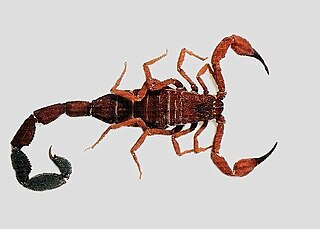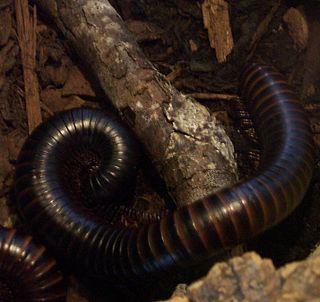
The wildcat is a species complex comprising two small wild cat species: the European wildcat and the African wildcat. The European wildcat inhabits forests in Europe, Anatolia and the Caucasus, while the African wildcat inhabits semi-arid landscapes and steppes in Africa, the Arabian Peninsula, Central Asia, into western India and western China. The wildcat species differ in fur pattern, tail, and size: the European wildcat has long fur and a bushy tail with a rounded tip; the smaller African wildcat is more faintly striped, has short sandy-gray fur and a tapering tail; the Asiatic wildcat is spotted.

Lithobius is a large genus of centipedes in the family Lithobiidae, commonly called stone centipedes, common centipedes or brown centipedes.

The African wildcat is a small wildcat species with sandy grey fur, pale vertical stripes on the sides and around the face. It is native to Africa, West and Central Asia, and is distributed to Rajasthan in India and Xinjiang in China. It inhabits a broad variety of landscapes ranging from deserts to savannas, shrublands and grasslands.

Poecilotheria is a genus of tarantulas native to India and Sri Lanka. It was first described by Eugène Louis Simon in 1885. They are arboreal tarantulas, commonly known as ornamental tarantulas, known for their vivid color patterns, fast movement, and potent venom compared to other tarantulas. As of 2019 all species are protected under CITES.

Tityus is a large genus of thick-tailed scorpions, the namesake of its subfamily Tityinae. As of 2021, Tityus contains more than 220 described species distributed in Central America and South America, from Costa Rica to Argentina. Species in the genus Tityus have been studied for hundreds of years, long before the taxonomic classification was put in place. Tityus tend to be of medium size for scorpions, roughly 50 to 70 millimeters long. They are dark brown or red in color, and can exhibit sexual dimorphism. They can live in a variety of environments, ranging from urban to arid mountains to the Amazon Rainforest. Tityus scorpions are best known for their venom and potent sting. The genus contains several dangerously venomous scorpions, the best known of which is the Brazilian yellow scorpion, T. serrulatus. Its venom can cause severe illness, and in the young, old and infirm even death. Some experts have argued that the genus as a whole may be paraphyletic, which could explain the knowledge gaps related to Tityus.

Polydesmida is the largest order of millipedes, containing approximately 3,500 species, including all the millipedes reported to produce hydrogen cyanide (HCN). Polydesmids grow and develop through a series of moults, adding segments until they reach a fixed number in the adult stage, which is usually the same for a given sex in a given species, at which point the moulting and the addition of segments and legs stop. This mode of development, known as teloanamorphosis, distinguishes this order from most other orders of millipedes, which usually continue to moult as adults, developing through either euanamorphosis or hemianamorphosis.

Spirostreptus is a genus of giant millipedes of the family Spirostreptidae. It contains the following species:

Julidae is a family of millipedes in the order Julida, containing more than 600 species in around 20 genera. Its members are largely confined to the Western Palaearctic, with only a few species extending into the Oriental and Afrotropical realms. They are united by a characteristic form of the mouthparts, and are classified in the superfamily Juloidea of the order Julida, alongside the families Trichoblaniulidae, Rhopaloiulidae and Trichonemasomatidae.

Chordeumatida is a large order of millipedes containing some 1200 species with a nearly worldwide distribution. Also known as sausage millipedes, they grow and develop through a series of moults, adding segments until they reach a fixed number in the adult stage, which is usually the same for a given sex in a given species, at which point the moulting and the addition of segments and legs stop. This mode of development, known as teloanamorphosis, distinguishes this order from most other orders of millipedes, which usually continue to moult as adults, developing through either euanamorphosis or hemianamorphosis.

Chilobrachys is a genus of Asian tarantulas that was first described by Ferdinand Anton Franz Karsch in 1892. They are found in India, Myanmar, Malaysia, China, Vietnam, Thailand and Sri Lanka. They are usually medium or large-sized, and they can stridulate by using small spines present on the chelicerae.

Geophilus is a large, heterogeneous genus of soil centipedes in the family Geophilidae largely considered to be synonymous with Brachygeophilus. This genus is mostly Holarctic and characterized by a claw-shaped ultimate pretarsus, complete or nearly complete coxo-pleural sutures at the prosternum, and incomplete chitin-lines. Centipedes in this genus feature slightly elongate heads and labral intermediate parts with tubercles, the forcipules are usually poorly elongate with a single small tubercle at the base of each tarsungulum, and the anterior trunk metasternites usually have an anterior medial socket and a posterior transversally elongate pore-field. The generic name first appeared in Brewster's Edinburgh Encyclopaedia in 1814 as Geophilus electricus.

Thyropygus is a genus of millipedes in the family Harpagophoridae, widely distributed throughout Southeast Asia. It is the most-species rich genus of Harpagophoridae in Southeast Asia. Over 30 species occur in Thailand.

Trigoniulus is a genus of millipede in the family Trigoniulidae. There are at least 90 described species in Trigoniulus.
Siphonophora is a genus of millipedes belonging to the family Siphonophoridae.

Cryptops sometimes known as cave centipedes, is a centipede genus in the family Cryptopidae; species records have a world-wide distribution.

Otostigmus is a genus of centipedes in the family Scolopendridae. It was first described by Swedish naturalist Carl Oscar von Porat in 1876. The genus as a whole comprises around 157 species, found primarily in the Neotropics.

Australobius is a genus of centipedes in the family Lithobiidae. It was described by American biologist Ralph Vary Chamberlin in 1920.
Paracryptops is a genus of centipedes in the family Cryptopidae. It was described in 1891 by British myriapodologist Reginald Innes Pocock.

Otostigminae is a large subfamily of centipedes, containing nearly half of all species in the family Scolopendridae. Members of this subfamily are abundant and widespread throughout the tropical and subtropical regions of the world, mostly in Africa, Asia, and Australia.

















